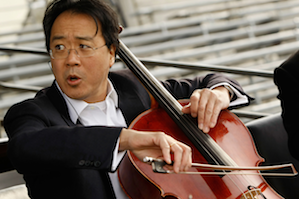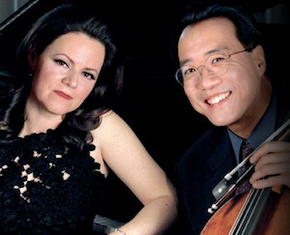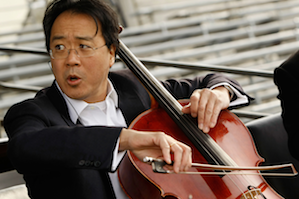
Yo-Yo Ma is arguably the greatest classical cellist alive, and he is definitely the most famous one. He can sell out concert venues of any size and he would probably even be successful if he ever decided to start doing ‘three tenors’-style stadium performances. Fortunately, Ma doesn’t seem that kind of person and musician, so I don’t think he ever will. But a celebrity he is.
With his long-time friend and musical partner, British pianist Kathryn Stott, Yo-Yo Ma is currently on a California tour that opened on Thursday at Berkeley’s Zellerbach Hall and leads via the two new Bay Area concert halls in Sonoma and Palo Alto to Davis and Southern California (Palm Desert and Aliso Viejo).
Ma and Stott have been working together for almost three decades. What binds them is an omnivorous, eclectic and all-inclusive approach to music and an urge to submerge themselves in a broad range of musical styles. Together and individually, they have delved deep into so many different musical styles that the label ‘classical musician’ has taken on a different meaning. And they approach every piece of music with the same sense of adventure and musical integrity.
One of their shared passions concerns the Tango and other South American dance music, as witnessed by the programming of wonderful pieces by Argentinian composer Astor Piazzolla (Oblivion) and his Brazilian counterparts Camargo Guarnieri (Dansa Negra) and Heitor Villa-Lobos (Alma Brasileira) — definitely stuff you wouldn’t have heard on a classical concert podium 30 years ago.
Other works on the program were Stravinsky’s Suite Italienne, based on themes from his ballet Pulcinella; Siete Canciones Populares Españolas by Manuel de Falla; and Louange à l'Éternité de Jésus by Olivier Messiaen (part five from the Quatuor pour la fin du temps). The only 19th century piece on the program, Sonata no 3 in D Minor, Op. 108 for violin by Johannes Brahms concluded the concert. Only the Messiaen and the Stravinsky are originally written for cello and piano; the others are arrangements made for Ma and Stott.
Musical Kinship
Judging from their online calendars, Ma and Stott go on tour together every few months. Their musical kinship shows in everything they do; they seem to be reading each other’s musical minds — or better still: Their musical minds work together as one. It is great to observe them interact on stage; the way they respond to each other and to each other’s playing is artistry in motion. Their musical mastery is above suspicion; a performance like this is no longer about notes and pitch, but about pure emotive expression.

And that is where Ma’s celebrity status gets in the way — or rather, the consequences of his stardom get in my way. Yo-Yo Ma doesn’t seem to have invited or pursued any part of fame he currently possesses; he has become a superstar classical musician just by being an awesome artist and human being.
Seeing a famous international artist at work is always wonderful, but the concert becomes so much else than a musical performance; it becomes an event, the place to be, a form of stargazing: the Yo-Yo Ma Experience. It becomes something to observe with detachment, from a distance — not something that transports you. In a way, Ma’s fame creates more distance.
Zellerbach Hall certainly doesn’t help — I am no fan of its acoustics and haven’t found it to be kind to any combination of musical instruments (let alone a cello-piano duo) and I have never felt close to anything on its stage. The overall concert experience will likely be different in a place with greater natural intimacy, like the Weill Hall in Sonoma. I am very happy that so many people come to enjoy Yo-Yo Ma, and he deserves every bit of his success, but short of having him perform in my living room, I think I prefer a CD and a good pair of headphones to really get close to Ma’s musical genius.

